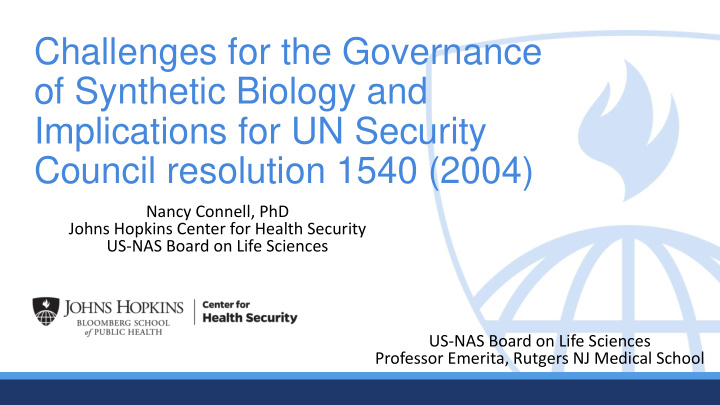



Challenges for the Governance of Synthetic Biology and Implications for UN Security Council resolution 1540 (2004) Nancy Connell, PhD Johns Hopkins Center for Health Security US-NAS Board on Life Sciences US-NAS Board on Life Sciences Professor Emerita, Rutgers NJ Medical School
Global markets are the drivers of advances in S&T The biotech market will grow at an average annual growth rate 11.6% (2012 to 2017) and reach a value worth USD 727.1 billion by 2025. The synthetic biology market will grow at an average annual growth rate of 44.2 %(2017-2020) and reach a value worth USD 38.7 billion by 2020. http://www.prnewswire.com/news-releases/ https://www.grandviewresearch.com/press-release/ global-biotechnology-market http://www.bio-itworld.com/ 2
What is synthetic biology? • SynBio collectively refers to concepts, approaches, and tools that enable the modification or creation of biological organisms. • SynBio is being pursued overwhelmingly for beneficial purposes ranging from reducing the burden of disease to improving agricultural yields to remediating pollution. 3
However…. It is also possible to imagine malicious uses that could lead to events that might threaten the health and safety of citizens, destabilize governments, disrupt social enterprises, destroy agriculture and the global economy, and imperil the very survival of the planet. 4
Enabling technologies for synbio • DNA/RNA/protein sequencing and synthesis • Microfluidicis • Nanotechnology • Modularity • Robotics • Synthetic transcription factors • Biosensors 5
Key SynBio approaches in use Approach Beneficial application Re-creating known bacteria, viruses, algae Vaccine design, other MCMs Making existing pathogens more dangerous Pathogenesis studies Creating new bacteria or viruses Biofuel production or cleanup Manufacturing chemicals using metabolic pathways Pharmaceuticals, biofuels Modifying the human microbiome Reprogramming the gut Modifying the human immune system Immunotherapeutics Modifying the human genome Somatic vs germ line 6
7
Framework for assessing concern 1. Usability of the technology 2. Usability as a weapon 3. Requirements of actors 4. Potential for mitigation Biodefense in the age of synthetic biology, US-NASEM 2018 8
Scientists Build First Man-Made Genome; Synthetic Life Comes Next By Alexis Madrigal 01.24.08 | 11:00 AM 9
10
The Venter Experiments 1.
The Venter Experiments 1. 2.
The Venter Experiments 1. 2. 3.
16
17
18
19
20
Manufacturing chemicals • Medicines produced by plants and microbes have been used for centuries (infections, pain, hypertension, etc) • Other chemicals include fuels, commodity and specialty chemicals, food ingredients • Metabolic engineering of ever increasing complex pathways • Harmful chemicals : toxins, anti-metabolites, controlled substances (opioids, explosives, chemical weapons) 21
Modifying the human microbiome Why - Human health is highly dependent on the microbiome Active area of research – correction of metabolic disorders in clinic Methods - Delivery of harmful cargo via the microbiome. Use of the microbiome to increase the impact of an attack. Engineered dysbiosis Problems - Enormous variation across populations Homeostasis of the system – difficult to engineer 22
Modifying the human immune system • Immune system is what defends us against infection; many pathogens attack by directly affecting the function of the immune system. • Explosion in work on immunotherapy • Engineering immune deficiency, hyperactivity, autoimmunity • The current state of knowledge regarding immunity is such that it is likely far easier to craft an immunomodulatory weapon than an effective response to one (as we learned from HIV/AIDS) 23
Modifying the human genome • It may be possible to insert engineered genes directly into the human genome via horizontal transfer, using CRISPR or nano- lipid delivery. (vaccines, cellular reprogramming) • Deletions or additions of genes, epigenetic modifications, small RNAs, CRISPR/Cas9, CRISPR-RNP. • cause non-infectious disease, such as cancer or neurological debilitation, or to degrade immunity. 24
Digitization of biology An example of how the digitization of biology accelerates vaccine development: The Novartis H7N9 influenza vaccine response – combining synthetic virus generation with flu cell culture platform 25
Genomics: gene drives • Mosquitoes and malaria: • engineer mosquito populations for infertility • engineer mosquitoes to be unable to carry malaria 26
Genomics: gene drives 27
28
Rose oil from yeast Plants that fix N 29
NASEM 2018 30
Applications Consequence management of SynBio Malicious use MCMs Cures, solutions detection and improvements prevention attribution regulation 31
Recommend
More recommend